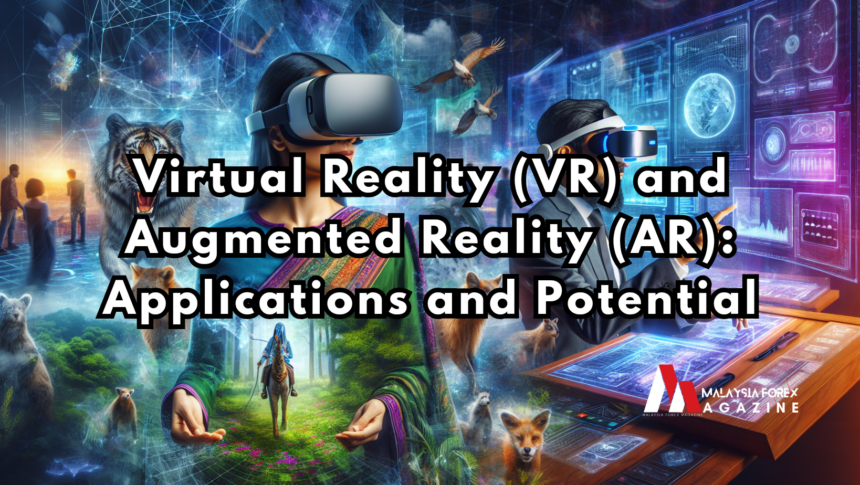In recent years, Virtual Reality (VR) and Augmented Reality (AR) have become two of the most transformative technologies across various industries. While both technologies immerse users in digital environments, they differ in their approach. VR creates entirely virtual spaces, whereas AR overlays digital elements onto the real world. This article explores the key applications and potential of these cutting-edge technologies.
Understanding VR and AR
Virtual Reality (VR)
Virtual Reality immerses users in a fully simulated environment, typically accessed through VR headsets like the Oculus Quest, HTC Vive, or PlayStation VR. These headsets often come with controllers or sensors to track user movements, creating interactive experiences.
Augmented Reality (AR)
Augmented Reality enhances the physical world by overlaying digital content such as images, text, or animations. AR experiences can be accessed using smartphones, tablets, or AR glasses like Microsoft HoloLens or Magic Leap.
Key Applications of VR and AR
1. Gaming and Entertainment
- VR: Immersive games such as Beat Saber and Half-Life: Alyx have transformed the gaming industry, offering players an unprecedented level of engagement.
- AR: Mobile games like Pokémon GO showcase the potential of AR by blending virtual elements with the real world, creating interactive outdoor experiences.
2. Healthcare
- VR: Medical professionals use VR for surgical training, allowing them to practice procedures in a risk-free environment. It is also utilized for pain management and mental health therapies, such as exposure therapy for phobias.
- AR: AR aids in surgeries by providing real-time overlays of critical information, such as 3D models of organs, improving precision and reducing risks.
3. Education and Training
- VR: Virtual classrooms and immersive learning environments enable students to explore historical events, distant planets, or complex scientific concepts in 3D.
- AR: AR enhances learning materials by providing interactive visualizations, such as displaying 3D models of molecules or historical landmarks.
4. Retail and E-Commerce
- VR: Retailers use VR to create virtual stores, allowing customers to browse and shop from home in an immersive environment.
- AR: Apps like IKEA Place let users visualize furniture in their homes before purchasing, bridging the gap between online and in-store shopping.
5. Real Estate and Architecture
- VR: Virtual walkthroughs of properties give potential buyers a realistic sense of space without needing to visit in person.
- AR: Architects use AR to overlay designs onto construction sites, enabling better visualization and collaboration.
6. Manufacturing and Maintenance
- VR: Factories utilize VR for training workers on complex machinery and simulating assembly processes.
- AR: Technicians use AR glasses to access step-by-step instructions or visualize hidden components while repairing equipment.
7. Tourism and Travel
- VR: Virtual tours allow users to “visit” famous landmarks or explore destinations before making travel plans.
- AR: Travelers can use AR apps to access real-time information about attractions, including historical facts or navigation assistance.
The Potential of VR and AR
1. Enhanced Collaboration
Both VR and AR enable remote collaboration, especially in sectors like design, engineering, and education. Teams can interact with 3D models in real time, regardless of their physical location.
2. Accessibility
As hardware becomes more affordable and user-friendly, VR and AR are expected to reach a wider audience, democratizing access to immersive experiences.
3. Integration with AI
The integration of Artificial Intelligence (AI) with VR and AR can create smarter, more adaptive environments. For example, AI-driven AR apps can provide personalized recommendations or real-time translations.
4. Expansion into Everyday Life
From virtual social gatherings to AR-assisted navigation, these technologies have the potential to become part of daily life, reshaping how people interact with the world around them.
Challenges to Overcome
While the potential of VR and AR is immense, several challenges remain:
- Hardware Costs: High-quality devices can be expensive, limiting accessibility for some users.
- Content Development: Creating engaging and high-quality VR/AR content requires significant time and resources.
- Motion Sickness: Some users experience discomfort during VR experiences, which may deter adoption.
- Privacy Concerns: AR apps often rely on cameras and location data, raising concerns about user privacy.
Conclusion
Virtual Reality and Augmented Reality are reshaping industries and revolutionizing how people interact with digital and physical environments. As the technology evolves, its applications will continue to expand, driving innovation and transforming everyday experiences. By addressing current challenges, VR and AR have the potential to redefine the future of technology and human interaction.











